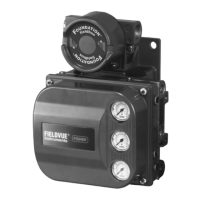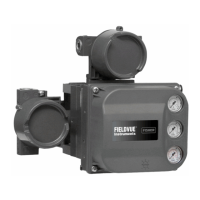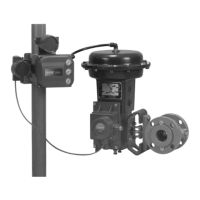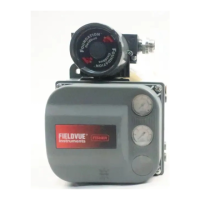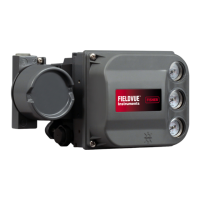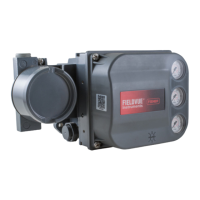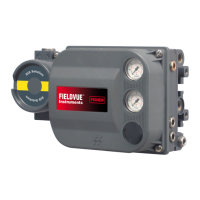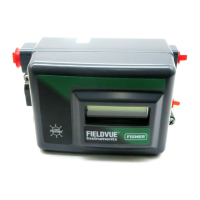Basic Setup
September 2013
3-3
Table 3-1. Factory Default Settings
Setup Parameter Default Setting
Analog Input Units
Analog In Range High
Analog In Range Low
Control Mode
Restart Control Mode
mA
20.0 mA
4.0 mA
Analog
Resume Last
Self-Test Shutdown
Setpoint Filter Time
Input Characterization
Travel Limit High
Travel Limit Low
All Failures Disabled
0 secs
Linear
125%
−25%
Travel Cutoff High
Travel Cutoff Low
Set Point Rate Open(1)
Set Point Rate Close(2)
Polling Address
99.5%
0.5%
0 %/secs
0 %/secs
0
Auxiliary Terminal Action
Cmd 3 Configured Pressure
For double-acting actuators
For single-acting actuators
Auxiliary Input Alert
differential output pressure
actuator pressure
1. In firmware 2 thru 6 this parameter is labeled Minimum Opening Time. In firmware
10 and below this parameter should be set to zero.
2. In firmware 2 thru 6 this parameter is labeled Minimum Closing Time. In firmware
10 and below this parameter should be set to zero.
3. Enter the maximum instrument supply pressure.
After entering the maximum instrument supply
pressure, the Setup Wizard prompts you for actuator
information.
4. Enter the manufacturer of the actuator on which
the instrument is mounted. If the actuator
manufacturer is not listed, select Other.
5. Enter the actuator model or type. If the actuator
model is not listed, select Other.
6. Enter the actuator size.
7. Select whether the valve is open or closed under
the zero power condition.
WARNING
In the next step, if you answer YES to
the prompt for permission to move
the valve when the Field
Communicator is determining the
travel sensor motion, the instrument
will move the valve through its full
travel range. To avoid personal injury
and property damage caused by the
release of pressure or process fluid,
provide some temporary means of
control for the process.
8. Specify if a volume booster or quick release valve
is present.
9. Specify if factory defaults should be used for basic
setup. If you select YES for factory default, the Field
Communicator sets the setup parameters to the
values listed in table 3-1. If you select NO for the
factory defaults, the setup parameters listed in the
table remain at their previous settings.
Typically the Setup Wizard determines the required
setup information based upon the actuator
manufacturer and model specified. However, if you
enter other for the actuator manufacturer or the
actuator model, then you will be prompted for setup
parameters such as:
Actuator style (spring & diaphragm, piston
double-acting without spring, piston single-acting with
spring, piston double-acting with spring),
Valve style (rotary or sliding stem),
On Loss of Instrument Signal (valve opens or
closes), see Zero Power Condition in the Detailed
Setup section.
Feedback connection (rotary-all, sstem-roller, or
sstem-standard), see Feedback Connection in the
Detailed Setup section.
Travel Sensor motion (increasing air pressure
causes the travel sensor shaft to rotate clockwise or
counterclockwise). The Field Communicator will ask if
it can move the valve to determine travel sensor
motion. If you answer yes, the instrument may stroke
the valve the full travel span to determine travel
sensor rotation. If you answer No, then you will have
to specify the rotation for increasing air pressure:
clockwise or counterclockwise. (see Travel Sensor
Motion in the Detailed Setup section).
Volume booster (indicate if volume booster or quick
release is present)
Tuning set (see Tuning Set in the Detailed Setup
section).
After completing the setup information, travel is
automatically calibrated. Follow the prompts on the
Field Communicator display. The calibration procedure
uses the valve and actuator stops as the 0% and
100% calibration points. For additional information,
refer to Auto Calibrate Travel on page 5-2 of the
Calibration section.
When travel calibration is complete, you are asked if
you wish to adjust the relay (double-acting only).
Select yes to adjust the relay. For additional
information, refer to Relay Adjustment on page 5-10 of
the Calibration section.
Note
Relay Adjustment is only available for
the double-acting relay (Relay A).
3
